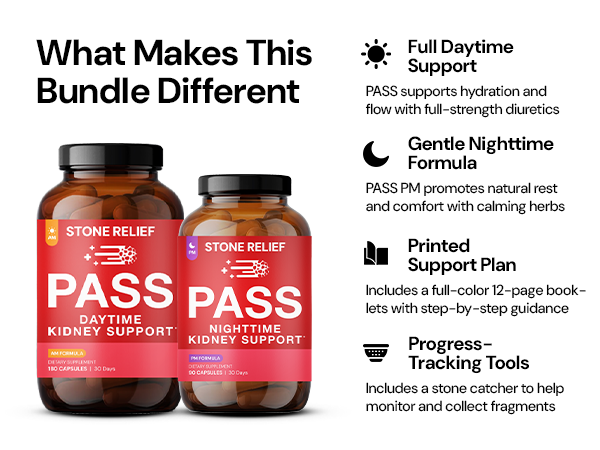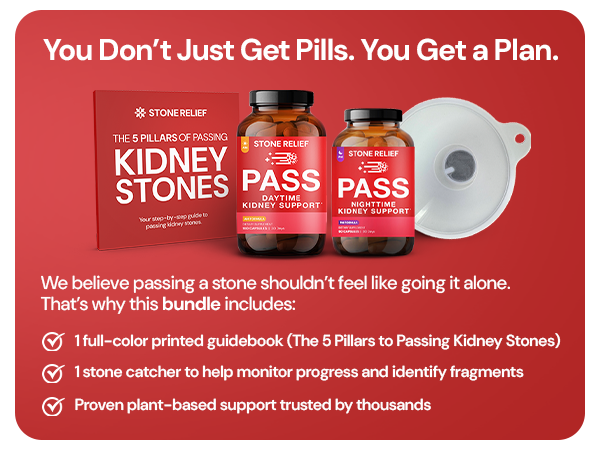3 Steps To Flush Out Stones Stuck In the Lower Urinary Tract
Kidney stones can sometimes pass naturally, especially when they reach the ureterovesical junction (UVJ) or bladder.By managing inflammation and increasing urinary pressure, individuals may facilitate the passage of these stones without surgical intervention. This blog outlines a three-step framework to aid in this process.
Key Takeaways:
-
Inflammation at the UVJ can impede stone passage.
-
NSAIDs can reduce inflammation, aiding stone movement.
-
Rapid water intake increases urinary pressure to help expel stones.
-
Proper timing and technique are crucial for success.
Understanding Kidney Stones and Their Journey
Kidney stones are hard deposits that form in the kidneys and can travel through the urinary tract. Their journey often ends when they are expelled from the body through urination. However, stones can sometimes become lodged, particularly at the UVJ—the point where the ureter meets the bladder. This area naturally narrows, making it a common site for stones to get stuck.
🛒 Check Price & Purchase Stone Relief Pass AM/PM Bundle on Amazon
Symptoms of a Stone Stuck at the UVJ
When a stone becomes lodged at the UVJ, individuals may experience:
-
Abdominal pain between the navel and genitals.
-
Flank or lower back pain due to urine backing up in the ureter, causing hydroureter.
-
Pain during urination as urine passes over the stone.
-
Nausea or vomiting in more severe cases.
-
Blood in the urine from irritation caused by the stone.
-
Potential urinary tract infections due to irritation and blockage.
-
In men, testicular pain may also occur.
Three-Step Framework to Aid Stone Passage
To facilitate the passage of a stone stuck at the UVJ, the following steps can be employed:
1. Manage Inflammation
-
Take a double dose of an NSAID (e.g., ibuprofen) as per the medication's guidelines.
-
Wait one hour to allow the medication to reduce inflammation at the UVJ.
2. Increase Urinary Pressure
-
Rapidly consume two liters (64 ounces) of water within 10-15 minutes.
-
This creates a surge in urine production, building pressure behind the stone.
3. Attempt to Expel the Stone
-
After another hour, when the urge to urinate is strong, go to the bathroom.
-
Begin urinating normally, then bear down using abdominal muscles to increase the force of urination, aiming to push the stone through the UVJ into the bladder.
If the stone does not pass, wait four hours and repeat the process. Persistence is key, and many find success after a few attempts.
🛒 Check Price & Purchase Stone Relief Pass AM/PM Bundle on Amazon
Addressing Stones Stuck in the Bladder
Occasionally, a stone may pass through the UVJ but become lodged at the entrance to the urethra. Symptoms include:
-
A sensation of urgency to urinate.
-
Intermittent urine flow or difficulty starting urination.
-
A feeling of incomplete bladder emptying.
To address this:
-
Ensure the stone has returned to the bladder before attempting the following steps.
-
Repeat the three-step framework as described above, paying close attention to timing.
-
When urinating, start normally, then bear down to increase force, aiming to expel the stone through the urethra.
Again, if unsuccessful, wait four hours and repeat. Most stones will pass within 24 to 48 hours using this method.
Final Thoughts
While the idea of passing a kidney stone can be daunting, understanding the process and employing targeted strategies can empower individuals to manage the situation effectively. By reducing inflammation and increasing urinary pressure, many stones can be passed without surgical intervention. Always consult with a healthcare professional before beginning any treatment regimen.
🛒 Check Price & Purchase Stone Relief Pass AM/PM Bundle on Amazon








